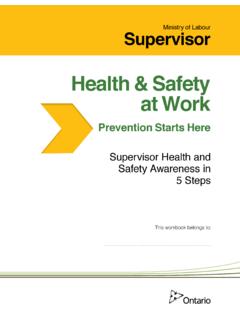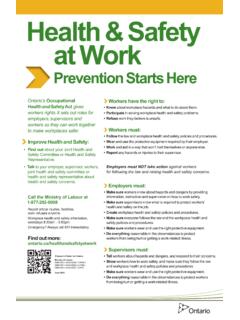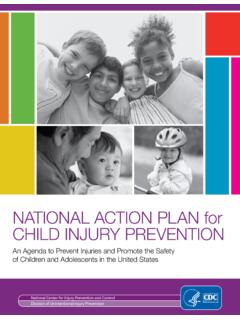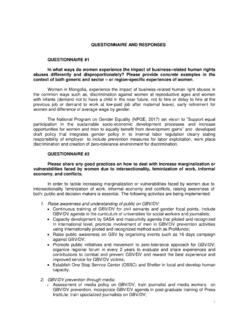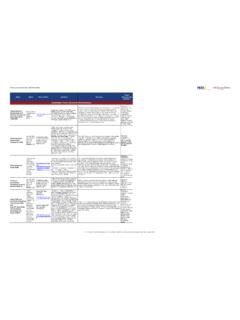Transcription of Health & Safety at Work - Ministry of Labour
1 Ministry of LabourWorkerHealth & Safety at Work prevention Starts HereWorker Health and Safety awareness in 4 StepsThis workbook belongs to:2 Table of ContentsIntroduction 03 Step 1: Get on Board04 Everyone has a role in safety04 How the Occupational Health and Safety Act works04 Duties of the employer05 Duties of the supervisor06 Duties of the worker06 Rights of the worker07 Step 1 quiz08 Step 2: Get in the Know09 You need to know about hazards09 Some common workplace hazards09 Protecting you from hazards11 Protective equipment and devices11 Other ways to find out about hazards11 Step 2 quiz13 Step 3: Get Involved14 Working together for safety14 The right to participate in Health and safety14 Health and Safety representatives and Health and Safety committees14 What to look for and what to ask15Be a Safety role model16 Step 3 quiz17 Step 4: Get More Help18 You are not alone18 The right to refuse unsafe work18 More information and resources19 Step 4 quiz21 What s next?
2 22 Answers to quiz questions23 Note: This document does not constitute legal advice. To determine your rights and obligations under the Occupational Health and Safety Act and its regulations, please contact your legal counsel or refer to the legislation at: workbook explains your rights and responsibilities on the job and tells you what Ontario s Occupational Health and Safety Act (OHSA) expects from your employer, your supervisor and you. These are things you need to know and understand so that you can be safe at work today and every day. Everyone in the workplace, from the employer to the newest worker, has different but important duties to keep the workplace safe. Because employers have the most authority in the workplace, they have the greatest responsibility but it s important for your own Safety that you understand everyone s Health and Safety duties, including yours.
3 Preventing injuries and illnesses at work starts here, with the things you learn in this workbook, but it doesn t end here. One of your employer s duties under the OHSA is to give you specific information and instructions about how to stay safe on your job. What you learn from this program will help you start to understand those instructions. We hope you will use what you learn here every day of your working 1: Get On BoardEveryone has a role in safetyA new job is a chance for a fresh start. You re learning new skills and meeting new people. But every job has hazards, no matter how safe it looks. The number of people in Ontario who suffer a work-related illness or injury each year would fill the seats of a dozen big hockey arenas. From the list below, who do you think is more likely to get hurt or sick on the job? Check one of the boxes and explain why.
4 1. New and young workers Why? 2. Experienced workers Why? The right answer is #1. Studies show that new and young workers in Ontario are four times more likely to get hurt during their first month on the job than at any other s because they often aren t told about or don t understand the hazards of the job. They don t know what to expect from their employer, their supervisor, and of themselves. Sometimes they aren t sure what questions to ask. Sometimes they don t even know who to s where the law comes the Occupational Health and Safety Act worksThe OHSA is a set of laws that spells out the duties of employers, supervisors and the rights and duties of workers. There are also different Regulations that are attached to the OHSA. They contain more detailed laws about how to make the workplace safe in specific situations.
5 For example, several Regulations explain what is needed to work safely with chemicals and other hazardous materials. This includes training, warning labels on products and information sheets. There are also Regulations for different types of workplaces, such as construction projects, Health care facilities, industrial establishments and whole point of the OHSA and Regulations is to keep workers from getting hurt or sick on the job. There are inspectors from the Ministry of Labour who make sure the laws are followed and may issue orders or lay charges if they aren t. If a person is convicted of breaking the law, there are penalties such as fines or time in prison. 5 The OHSA gives everyone in the workplace duties. These duties are connected to the level of authority each person has in the workplace. To sort out all the duties in a workplace, the OHSA breaks them down to three main levels of authority:1.
6 The employer (who is in charge of everyone)2. the supervisor3. the worker (you).To which of these three people do you think the OHSA gives the most duties?Check one of the boxes below and explain The employer Why? 2. The supervisor Why? 3. The worker Why? The right answer is #1 the employer. The more authority a person has in the workplace, the more Health and Safety duties they have. It s important for your Safety that you understand everyone s Health and Safety duties. Duties of the employerHere are some of the things the OHSA says every employer has to do as part of their job:1. Make sure workers know about hazards and dangers in the workplace and how to work Make sure every supervisor knows how to take care of Health and Safety on the job. 3. Create Health and Safety policies and procedures for the Make sure everyone knows and follows the Health and Safety Make sure workers wear and use the right protective Do everything reasonable to keep workers from getting hurt or sick on the of the supervisorHere are some of the things the OHSA says every supervisor has to do as part of their job:1.
7 Tell workers about hazards and dangers in the workplace and show them how to work Make sure workers follow the law and the workplace Health and Safety policies and Make sure workers wear and use the right protective Do everything reasonable to keep workers from getting hurt or sick on the of the workerNow here are some of the things the OHSA says every worker has to do as part of their job:1. Follow the law and the workplace Health and Safety policies and procedures. 2. Always wear or use the protective equipment that the employer Work and act in a way that won t hurt them or any other Report any hazard they find in the workplace to their you have been asked to do something that you don t know very much about. What should your employer and your supervisor do to make sure you are able to do it safely? Explain in the space below.
8 The people who made the OHSA thought about that question, too. The Act says that your supervisor and your employer have to take every precaution reasonable in the circumstances for your protection. That means they have to do everything that is reasonable to protect you on the of the workerYour employer has the responsibility to make the workplace as safe as possible and to tell you about any hazards in the work you do. Your supervisor has the same duty. They also have to make sure you know how to avoid those dangers and work safely. You have the right under the OHSA to be told about the hazards in the work you do and to be instructed on how to do your work someone asks you to do work that you don t know enough about, your employer and supervisor are responsible for making sure you know how to do the work safely. That s why you have the right to speak up and ask questions even if you are shy or unsure.
9 People can get hurt on the job if they don t have the right information and should never have to be worried that you will get in trouble for asking questions or reporting a problem. It s against the law for your employer or your supervisor to punish you in any way for doing what the OHSA says or for asking your employer or supervisor to do what the OHSA expects them to do. This is called a reprisal. It s even against the law for your supervisor or employer to threaten to punish or fire you for doing these things. You also have a right to refuse to do unsafe work if you have reason to believe it puts you or a fellow worker in danger. We will look at this right and your protection from reprisals in more detail later. prevention starts here, but it doesn t end 1 quizBefore we move on to Step 2 of the program, here is a short quiz on the material we have just covered.
10 (The answers are in the back of the workbook, but please don t look at them ahead of time.)1. The number of people in Ontario who suffer a work-related illness or injury each year would fill the seats of a dozen big hockey No 2. New workers are less likely to get hurt on the job than people who have beenon the job No 3. The Occupational Health and Safety Act and Regulations tell everyone from the employer to the newest worker how to make the workplace No 4. The OHSA puts the greatest responsibility on the employer to make sure no one gets hurt or sick on the No 5. It s against the law for my employer to fire or punish me for doing what the OHSA No 9 Step 2: Get in the KnowYou need to know about hazardsSome people say that what you don t know can t hurt you.
